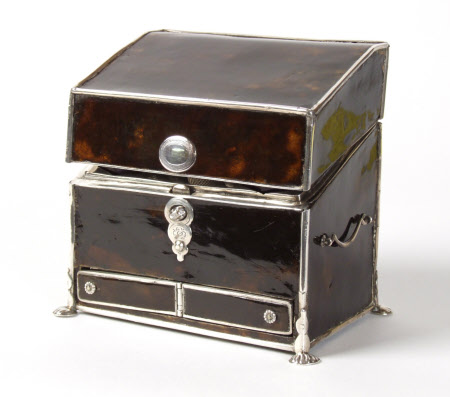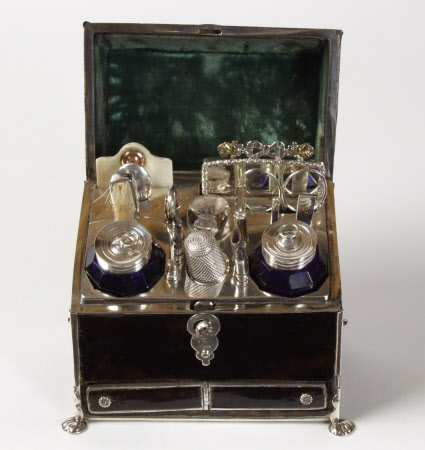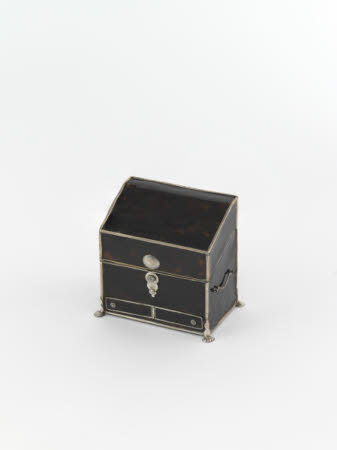Necessaire
Category
Silver
Date
c. 1790
Materials
Silver, Tortoiseshell, Diamond, Glass, Silk velvet
Measurements
100 mm (H)108 mm (W)72 mm (D)
Order this imageCollection
Polesden Lacey, Surrey
NT 1246859
Summary
Nécessaire, silver and tortoiseshell, possibly Paris, circa 1790. The nécessaire, which has a sloping, hinged lid, is in the form of a casket with a silver frame and tortoiseshell panels. The silver lock-plate has a diamond thumbpiece and there are silver swing handles and silver mounts to the hinged covers at the base concealing two drawers, also silver and with hinged pull handles. The main compartment inside has a green silk velvet lining to the lid and a silver locating plate with shaped holes lined with green silk velvet for various utensils connected to writing and the toilet. There are two blue-glass bottles (for ink and sand) with silver tops, a pair of tweezers, pens, ivory writing leaves, a thimble, a spoon, a pair of scissors, a silver-handled brush and a looking glass with a gadrooned silver frame crested by a bow. The glass has a hinged foot at the rear to allow it to stand at an angle. A faceted rock crystal seal is probably English, circa 1790, and is engraved with the initials ‘HMB’ beneath a baron’s coronet for Henrietta Maria Hill, Lady Bruce (1769-1831).
Full description
Miniature chests such as this were intended for travelling and contain the ‘necessaries’ for writing, sewing and dressing - hence their name. They were also exquisite objets de vertu, to be admired for their craftmanship and precious materials and it was certainly for this latter quality that Mrs Greville would have acquired it at some point in the early 20th century. The first known owner, identified by the monogram and coronet on the rock crystal seal, was the Hon. Henrietta Maria Hill, eldest daughter of the 1st Lord Berwick of Attingham Park, Shropshire. She proved an intrepid traveller, and following her father’s death in early 1789 she made her way to Italy with her mother and two sisters, presumably travelling through France at the time of or just before the Revolution. The four women were in Florence in 1793 when Henrietta Maria was thrown from a bucking horse and was rescued by Charles, Lord Bruce (1773-1856). The pair were married on the 10th April, 1793 and the nécessaire may have been a wedding present from husband to wife. Lord Bruce succeeded his father as 2nd Earl of Ailesbury in 1814 and was created Marquess of Ailesbury in 1821. Lady Ailesbury died in 1831. Her portrait by Sir Thomas Lawrence, commenced in 1809 and finished in his studio after his death in 1830, is at her childhood home, Attingham Park near Shrewsbury (NT 608955). James Rothwell, National Curator, Decorative Arts February, 2023
Provenance
Henrietta Maria Hill, Marchioness of Ailesbury (1769-1831) and probably thence by descent until presumably sold in the early 20th century; acquired by Margaret Anderson, the Hon. Mrs Ronald Greville, DBE (1863-1942), by whom bequeathed to the National Trust with the Polesden Lacey estate in memory of her father, William McEwan (1827-1913). Recorded in the Tea Room at Polesden Lacey in the probate valuation of 1943 (p. 30).
Credit line
Polesden Lacey, the Greville Collection (National Trust)





